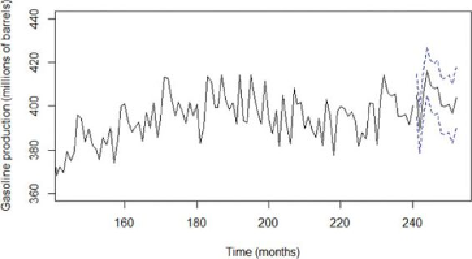Database Reference
In-Depth Information
Figure 8.22
Actual and forecasted gasoline production
8.2.6 Reasons to Choose and Cautions
One advantage of ARIMA modeling is that the analysis can be based simply on
historical time series data for the variable of interest. As observed in the chapter
about regression (Chapter 6), various input variables need to be considered and
evaluated for inclusion in the regression model for the outcome variable. Because
ARIMA modeling, in general, ignores any additional input variables, the
forecasting process is simplified. If regression analysis was used to model gasoline
production, input variables such as Gross Domestic Product (GDP), oil prices,
and unemployment rate may be useful input variables. However, to forecast the
gasoline production using regression, predictions are required for the GDP, oil
price, and unemployment rate input variables.
The minimal data requirement also leads to a disadvantage of ARIMA modeling;
the model does not provide an indication of what underlying variables affect the
outcome. For example, if ARIMA modeling was used to forecast future retail sales,
the fitted model would not provide an indication of what could be done to increase
sales. In other words, causal inferences cannot be drawn from the fitted ARIMA
model.
One caution in using time series analysis is the impact of severe shocks to the
system. In the gas production example, shocks might include refinery fires,
international incidents, or weather-related impacts such as hurricanes. Such
events can lead to short-term drops in production, followed by persistently high
increases in production to compensate for the lost production or to simply
capitalize on any price increases.

